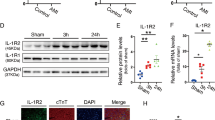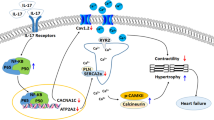Abstract
Inflammatory responses play an important role in the pathogenesis of adverse ventricular remodeling after myocardial infarction (MI). We previously demonstrated that interleukin (IL)-17A plays a pathogenic role in myocardial ischemia/reperfusion injury and viral myocarditis. However, the role of IL-17A in post-MI remodeling and the related mechanisms have not been fully elucidated. Acute MI was induced by permanent ligation of the left anterior descending coronary artery in C57BL/6 mice. Repletion of IL-17A significantly aggravated both early- and late-phase ventricular remodeling, as demonstrated by increased infarct size, deteriorated cardiac function, increased myocardial fibrosis, and cardiomyocyte apoptosis. By contrast, genetic IL-17A deficiency had the opposite effect. Additional studies in vitro indicated that IL-17A induces neonatal cardiomyocyte (from C57BL/6 mice) apoptosis through the activation of p38, p53 phosphorylation, and Bax redistribution. These data demonstrate that IL-17A induces cardiomyocyte apoptosis through the p38 mitogen-activated protein kinase (MAPK)-p53-Bax signaling pathway and promotes both early- and late-phase post-MI ventricular remodeling. IL-17A might be an important target in preventing heart failure after MI.
Key message
• We demonstrated that IL-17A plays a pathogenic role both in the early and late stages of post-MI remodeling.
• IL-17A induces murine cardiomyocyte apoptosis.
• IL-17A induces murine cardiomyocyte apoptosis through the p38 MAPK-p53-Bax signaling pathway.








Similar content being viewed by others
References
Nian M, Lee P, Khaper N, Liu P (2004) Inflammatory cytokines and postmyocardial infarction remodeling. Circ Res 94:1543–1553
Gaffen SL (2009) Structure and signalling in the IL-17 receptor family. Nat Rev Immunol 9(8):556–567
Roark CL, Simonian PL, Fontenot AP, Born WK, O’Brien RL (2008) Curr Opin Immunol 20(3):353–357
Maddur MS, Miossec P, Kaveri SV, Bayry J (2002) Th17 cells: biology, pathogenesis of autoimmune and inflammatory diseases, and therapeutic strategies. Am J Pathol 181(1):8–18
Madhur MS, Lob HE, McCann LA, Iwakura Y, Blinder Y, Guzik TJ, Harrison DG (2010) Interleukin 17 promotes angiotensin II-induced hypertension and vascular dysfunction. Hypertension 55(2):500–507
Liao YH, Xia N, Zhou SF, Tang TT, Yan XX, Lv BJ, Nie SF, Wang J, Iwakura Y, Xiao H et al (2012) Interleukin-17A contributes to myocardial ischemia/reperfusion injury by regulating cardiomyocyte apoptosis and neutrophil infiltration. J Am Coll Cardiol 59(4):420–429
Yan X, Shichita T, Katsumata Y, Matsuhashi T, Ito H, Ito K, Anzai A, Endo J, Tamura Y, Kimura K et al (2012) Deleterious effect of the IL-23/IL-17A axis and γδT cells on left ventricular remodeling after myocardial infarction. J Am Heart Assoc 1(5):e004408
Nakae S, Komiyama Y, Nambu A, Sudo K, Iwase M, Homma I, Sekikawa K, Asano M, Iwakura Y (2002) Antigen-specific T cell sensitization is impaired in IL-17-deficient mice, resulting in the suppression of allergic cellular and humoral responses. Immunity 17:375–387
Rui T, Cepinskas G, Feng Q, Ho YS, Kvietys PR (2008) Wide-spread myocardial remodeling after acute myocardial infarction in rat. Features for heart failure progression. Vascul Pharmacol 48(2–3):100–108
Janicki JS, Brower GL, Gardner JD, Chancey AL, Stewart JA Jr (2004) The dynamic interaction between matrix metalloproteinase activity and adverse myocardial remodeling. Heart Fail Rev 9(1):33–42
Whelan RS, Kaplinskiy V, Kitsis RN (2010) Cell death in the pathogenesis of heart disease: mechanisms and significance. Annu Rev Physiol 72:19–44
Junttila MR, Li SP, Westermarck J (2008) Phosphatase-mediated crosstalk between MAPK signaling pathways in the regulation of cell survival. FASEB J 22(4):954–965
Roussel L, Houle F, Chan C, Yao Y, Bérubé J, Olivenstein R, Martin JG, Huot J, Hamid Q, Ferri L et al (2010) IL-17 promotes p38 MAPK-dependent endothelial activation enhancing neutrophil recruitment to sites of inflammation. J Immunol 184(8):4531–4537
Fridman JS, Lowe SW (2003) Control of apoptosis by p53. Oncogene 22(56):9030–9040
Kolls JK, Lindén A (2004) Interleukin-17 family members and inflammation. Immunity 21(4):467–476
Cheng X, Yu X, Ding YJ, Fu QQ, Xie JJ, Tang TT, Yao R, Chen Y, Liao YH (2008) The Th17/Treg imbalance in patients with acute coronary syndrome. Clin Immunol 127(1):89–97
Ávalos AM, Apablaza FA, Quiroz M, Toledo V, Peña JP, Michea L, Irarrázabal CE, Carrión FA, Figueroa FE (2012) IL-17A levels increase in the infarcted region of the left ventricle in a rat model of myocardial infarction. Biol Res 45(2):193–200
Shichita T, Sugiyama Y, Ooboshi H, Sugimori H, Nakagawa R, Takada I, Iwaki T, Okada Y, Iida M, Cua DJ et al (2009) Pivotal role of cerebral interleukin-17-producing gammadeltaT cells in the delayed phase of ischemic brain injury. Nat Med 15(8):946–950
Cheng XW, Huang Z, Kuzuya M, Okumura K, Murohara T (2011) Cysteine protease cathepsins in atherosclerosis-based vascular disease and its complications. Hypertension 58:978–986
Cheng XW, Shi GP, Kuzuya M, Sasaki T, Okumura K, Murohara T (2012) Role for cysteine protease cathepsins in heart disease: focus on biology and mechanisms with clinical implication. Circulation 125:1551–1562
Qin Y, Cao X, Guo J, Zhang Y, Pan L, Zhang H, Li H, Tang C, Du J, Shi GP (2012) Deficiency of cathepsin S attenuates angiotensin II-induced abdominal aortic aneurysm formation in apolipoprotein E-deficient mice. Cardiovas Res 96:401–410
Hua Y, Xu X, Shi GP, Chicco AJ, Ren J, Nair S (2013) Cathepsin K knockout alleviates pressure overload-induced cardiac hypertrophy. Hypertension 61(6):1184–1192
Koenders MI, Lubberts E, Oppers-Walgreen B, van den Bersselaar L, Helsen MM, Di Padova FE, Boots AM, Gram H, Joosten LA, van den Berg WB (2005) Blocking of interleukin-17 during reactivation of experimental arthritis prevents joint inflammation and bone erosion by decreasing RANKL and interleukin-1. Am J Pathol 167(1):141–149
Zhang F, Tanaka H, Kawato T, Kitami S, Nakai K, Motohashi M, Suzuki N, Wang CL, Ochiai K, Isokawa K et al (2011) Interleukin-17A induces cathepsin K and MMP-9 expression in osteoclasts via celecoxib-blocked prostaglandin E2 in osteoblasts. Biochimie 93(2):296–305
Bialik S, Geenen DL, Sasson IE, Cheng R, Horner JW, Evans SM, Lord EM, Koch CJ, Kitsis RN (1997) Myocyte apoptosis during acute myocardial infarction in the mouse localizes to hypoxic regions but occurs independently of p53. J Clin Invest 100(6):1363–1372
Kajstura J, Cheng W, Reiss K, Clark WA, Sonnenblick EH, Krajewski S, Reed JC, Olivetti G, Anversa P (1996) Apoptotic and necrotic myocyte cell deaths are independent contributing variables of infarct size in rats. Lab Invest 74(1):86–107
Yao YY, Yin H, Shen B, Chao L, Chao J (2007) Tissue kallikrein infusion prevents cardiomyocyte apoptosis, inflammation and ventricular remodeling after myocardial infarction. Regul Pept 140(1–2):12–20
Erbel C, Chen L, Bea F, Wangler S, Celik S, Lasitschka F, Wang Y, Böckler D, Katus HA, Dengler TJ (2009) Inhibition of IL-17A attenuates atherosclerotic lesion development in apoE-deficient mice. J Immunol 183(12):8167–8175
Zhu F, Wang Q, Guo C, Wang X, Cao X, Shi Y, Gao F, Ma C, Zhang L (2011) IL-17 induces apoptosis of vascular endothelial cells: a potential mechanism for human acute coronary syndrome. Clin Immunol 141(2):152–160
Lee SY, Kwok SK, Son HJ, Ryu JG, Kim EK, Oh HJ, Cho ML, Ju JH, Park SH, Kim HY (2013) IL-17-mediated Bcl-2 expression regulates survival of fibroblast-like synoviocytes in rheumatoid arthritis through STAT3 activation. Arthritis Res Ther 15(1):R31
Zizzo G, Cohen PL (2013) IL-17 Stimulates differentiation of human anti-inflammatory macrophages and phagocytosis of apoptotic neutrophils in response to IL-10 and glucocorticoids. J Immunol 190(10):5237–5246
Youle RJ, Strasser A (2008) The BCL-2 protein family: opposing activities that mediate cell death. Nat Rev Mol Cell Biol 9(1):47–59
Mackay K, Mochly-Rosen D (1999) An inhibitor of p38 mitogen-activated protein kinase protects neonatal cardiac myocytes from ischemia. J Biol Chem 274(10):6272–6279
She QB, Bode AM, Ma WY, Chen NY, Dong Z (2001) Resveratrol-induced activation of p53 and apoptosis is mediated by extracellular-signal-regulated protein kinases and p38 kinase. Cancer Res 61(4):1604–1610
Takekawa M, Adachi M, Nakahata A, Nakayama I, Itoh F, Tsukuda H, Taya Y, Imai K (2000) p53-inducible wip1 phosphatase mediates a negative feedback regulation of p38 MAPK-p53 signaling in response to UV radiation. EMBO J 19(23):6517–6526
Ito K, Nakazato T, Yamato K, Miyakawa Y, Yamada T, Hozumi N, Segawa K, Ikeda Y, Kizaki M (2004) Induction of apoptosis in leukemic cells by homovanillic acid derivative, capsaicin, through oxidative stress: implication of phosphorylation of p53 at Ser-15 residue by reactive oxygen species. Cancer Res 64(3):1071–1078
Lavin MF, Gueven N (2006) The complexity of p53 stabilization and activation. Cell Death Differ 13(6):941–950
Acknowledgments
This work was supported by grants from the National Basic Research Program of China (973 Program: 2013CB531103 and 2012CB517805), the National Natural Science Foundation of China (Nos. 91339118, 81222002, 81170303, and 81200177), and the Scientific and Technological Issues of Wuhan City (201161038341–03).
Conflict of interest
There is no potential conflict that exist.
Author information
Authors and Affiliations
Corresponding author
Additional information
Su-Feng Zhou, Jing Yuan, and Meng-Yang Liao contributed equally to this study.
Electronic supplementary material
Below is the link to the electronic supplementary material.
ESM 1
(DOC 26070 kb)
Rights and permissions
About this article
Cite this article
Zhou, SF., Yuan, J., Liao, MY. et al. IL-17A promotes ventricular remodeling after myocardial infarction. J Mol Med 92, 1105–1116 (2014). https://doi.org/10.1007/s00109-014-1176-8
Received:
Revised:
Accepted:
Published:
Issue Date:
DOI: https://doi.org/10.1007/s00109-014-1176-8




